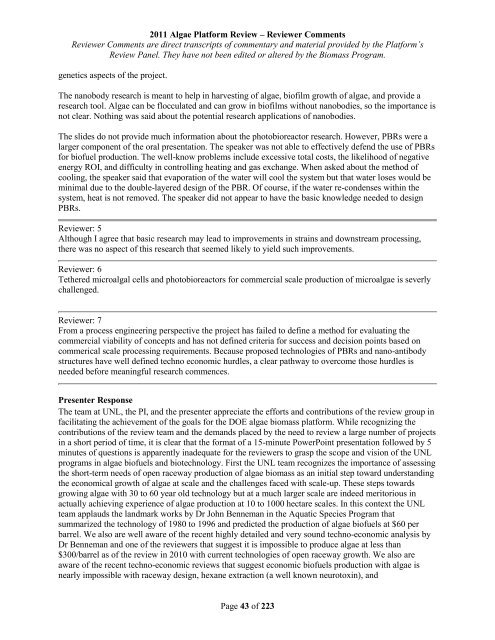Reviewer Comments - EERE
Reviewer Comments - EERE
Reviewer Comments - EERE
You also want an ePaper? Increase the reach of your titles
YUMPU automatically turns print PDFs into web optimized ePapers that Google loves.
2011 Algae Platform Review – <strong>Reviewer</strong> <strong>Comments</strong><br />
<strong>Reviewer</strong> <strong>Comments</strong> are direct transcripts of commentary and material provided by the Platform’s<br />
Review Panel. They have not been edited or altered by the Biomass Program.<br />
genetics aspects of the project.<br />
The nanobody research is meant to help in harvesting of algae, biofilm growth of algae, and provide a<br />
research tool. Algae can be flocculated and can grow in biofilms without nanobodies, so the importance is<br />
not clear. Nothing was said about the potential research applications of nanobodies.<br />
The slides do not provide much information about the photobioreactor research. However, PBRs were a<br />
larger component of the oral presentation. The speaker was not able to effectively defend the use of PBRs<br />
for biofuel production. The well-know problems include excessive total costs, the likelihood of negative<br />
energy ROI, and difficulty in controlling heating and gas exchange. When asked about the method of<br />
cooling, the speaker said that evaporation of the water will cool the system but that water loses would be<br />
minimal due to the double-layered design of the PBR. Of course, if the water re-condenses within the<br />
system, heat is not removed. The speaker did not appear to have the basic knowledge needed to design<br />
PBRs.<br />
<strong>Reviewer</strong>: 5<br />
Although I agree that basic research may lead to improvements in strains and downstream processing,<br />
there was no aspect of this research that seemed likely to yield such improvements.<br />
<strong>Reviewer</strong>: 6<br />
Tethered microalgal cells and photobioreactors for commercial scale production of microalgae is severly<br />
challenged.<br />
<strong>Reviewer</strong>: 7<br />
From a process engineering perspective the project has failed to define a method for evaluating the<br />
commercial viability of concepts and has not defined criteria for success and decision points based on<br />
commerical scale processing requirements. Because proposed technologies of PBRs and nano-antibody<br />
structures have well defined techno economic hurdles, a clear pathway to overcome those hurdles is<br />
needed before meaningful research commences.<br />
Presenter Response<br />
The team at UNL, the PI, and the presenter appreciate the efforts and contributions of the review group in<br />
facilitating the achievement of the goals for the DOE algae biomass platform. While recognizing the<br />
contributions of the review team and the demands placed by the need to review a large number of projects<br />
in a short period of time, it is clear that the format of a 15-minute PowerPoint presentation followed by 5<br />
minutes of questions is apparently inadequate for the reviewers to grasp the scope and vision of the UNL<br />
programs in algae biofuels and biotechnology. First the UNL team recognizes the importance of assessing<br />
the short-term needs of open raceway production of algae biomass as an initial step toward understanding<br />
the economical growth of algae at scale and the challenges faced with scale-up. These steps towards<br />
growing algae with 30 to 60 year old technology but at a much larger scale are indeed meritorious in<br />
actually achieving experience of algae production at 10 to 1000 hectare scales. In this context the UNL<br />
team applauds the landmark works by Dr John Benneman in the Aquatic Species Program that<br />
summarized the technology of 1980 to 1996 and predicted the production of algae biofuels at $60 per<br />
barrel. We also are well aware of the recent highly detailed and very sound techno-economic analysis by<br />
Dr Benneman and one of the reviewers that suggest it is impossible to produce algae at less than<br />
$300/barrel as of the review in 2010 with current technologies of open raceway growth. We also are<br />
aware of the recent techno-economic reviews that suggest economic biofuels production with algae is<br />
nearly impossible with raceway design, hexane extraction (a well known neurotoxin), and<br />
Page 43 of 223




